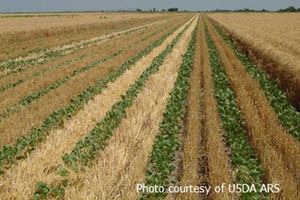New Relay Cropping Practice Insurable by Written Agreement for Soybeans Seeded into a Small Grain Crop
 Climate change, soil degradation, and depletion of natural resources are becoming prominent challenges for crop productivity and environmental sustainability in modern agriculture. Unfortunately, producers using conventional farming systems have limited choices available to cope with these issues.
Climate change, soil degradation, and depletion of natural resources are becoming prominent challenges for crop productivity and environmental sustainability in modern agriculture. Unfortunately, producers using conventional farming systems have limited choices available to cope with these issues.
Under the relay cropping practice, the first crop is harvested above the immature relay crop which limits damage to the relay crop. The relay crop is harvested later in the growing year during its normal harvest period.
Policyholders view relay cropping as a tool for crop diversification and environmental sustainability with a special focus on soil health and the potential of increasing overall production value on the acreage. This practice is growing in popularity among policyholders utilizing acres to produce two crops for harvest within the same crop year.
Per Managers Bulletin: MGR-22-002, for the 2022 and succeeding crop years, RMA will allow soybeans relay cropped into an established small grain crop to be insurable via a written agreement. To meet the policy requirements of 9(a)(2)(iii) of the Common Crop Insurance Policy Basic Provisions (CCIP Basic Provisions), RMA will create a new relay cropping practice, and insurance for the practice will only be available via written agreement, as provided in the bulletin.
Written Agreement Requirements:
To insure relay cropped soybeans, the policyholder must submit a request for a written agreement in accordance with Section 18 of the CCIP Basic Provisions and the 2022 Written Agreement Handbook. The written agreement request must:
- Be submitted as an unrated practice/type (TP) request type by the acreage reporting date deadline for new requests; and
- Include evidence of adaptability from an agricultural expert that relay cropping is an acceptable practice for the requested location.
In addition, RMA will utilize the zones defined in the NRCS Cover Crop Termination Guidelines to implement separate production requirements. Policyholders requesting a written agreement to insure the relay cropping practice in a county located in:
- Zones 1, 2, or 3 for a non-irrigated practice – must submit at least the most recent three years of their relay cropping actual production history from the county or area.
- Zone 4 for a non-irrigated practice or policyholders insuring soybeans under the irrigated practice – requires no prior relay cropping actual production history.
Access the bulletin to read the information in full and view the NRCS Cover Crop Termination Guidelines – Zone Guidance Map. Click here: https://rma.usda.gov/en/Policy-and-Procedure/Bulletins-and-Memos/2022/MGR-22-002
Reading Underwriting: Strength in the Field Newsletter? Click here for the next article.
